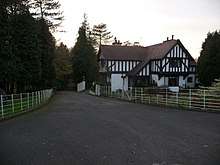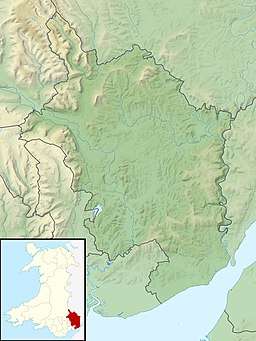Tredean House, Devauden
Tredean House, Devauden, Monmouthshire is a country house dating from 1901-02. It was designed in an Arts and Crafts style by the architect Arthur Jessop Hardwick. The client was a Henry Simpson. The house, a Grade II* listed building, remains a private residence and is not visible from the public highway, although the gatehouse can be seen.
| Tredean House, Devauden | |
|---|---|
 "A pert half-timbered lodge" - the only element of Tredean visible from the road | |
| Type | House |
| Location | Devauden, Monmouthshire |
| Coordinates | 51.6896°N 2.7571°W |
| Built | 1901-02 |
| Architect | Arthur Jessop Hardwick |
| Architectural style(s) | Arts and Crafts |
| Governing body | Privately owned |
Listed Building – Grade II* | |
| Official name: Tredean | |
| Designated | 8 September 2000 |
| Reference no. | 23978 |
Listed Building – Grade II | |
| Official name: Teahouse/Gazebo, steps and terracing at Tredean | |
| Designated | 8 September 2000 |
| Reference no. | 23979 |
Listed Building – Grade II | |
| Official name: Stable block and Garage at Tredean | |
| Designated | 8 September 2000 |
| Reference no. | 23980 |
Listed Building – Grade II | |
| Official name: Lodge at entrance to Tredean | |
| Designated | 8 September 2000 |
| Reference no. | 23981 |
 Location of Tredean House, Devauden in Monmouthshire | |
History
In the early 20th century the Dukes of Beaufort sold off their extensive Monmouthshire estates, centred on Troy House.[1] The site of Tredean was purchased by a Mr Henry Simpson,[2] who began the construction of a large house in the Arts and Crafts style.[2] His architect was Arthur Hardwick and the house was completed between 1901-02.[2] Tredean remains a private house which was marketed for £2.25m in 2002.[3] As of August 2020, the house, renamed Devauden Manor, is again for sale, with a guide price of £3.5M.[4] The house cannot be seen from the road, although the lodge, also in private ownership[5] and with its own Grade II listing,[6] and which the architectural historian John Newman considered "pert",[7] gives a flavour of the house's style.[6]
Architecture and description
John Newman describes Tredean as "a large and ambitious house in a loose Voyseyesque style".[7] Cadw records its terraced setting, on the side of a steep hill, "two-storey and-attic with a full basement due to the artificial ground level".[2] It describes the interior as "more Norman Shaw 'olde English' than Voysey" and notes the "very high standard" of the house's restoration in the very late 20th century.[2] The house is Grade II* listed,[2] with the lodge,[6] the stable block and garage,[8] and the teahouse in the garden,[9] all having their own Grade II listings. Coflein records that the house is "almost unaltered" since its construction.[10] The rooms in the house include a panelled entrance hall with stained glass, a dining room and sitting room with some reproduction fittings in the original style, a billiard room and a bathroom of 1902 with its "tiling and sanitary ware all complete".[2]
The terraced gardens surrounding the house were developed later, c.1910, but follow the Arts and Crafts style.[11]
Notes
- Benson 2017, p. 57.
- Cadw. "Tredean (Grade II*) (23978)". National Historic Assets of Wales. Retrieved 10 August 2020.
- "Yours for just £2,250,000 (From South Wales Argus)". Southwalesargus.co.uk. Retrieved 2017-08-24.
- "Devauden Manor, Devauden". Rightmove.co.uk. Retrieved 26 April 2019.
- "4 bedroom detached house for sale in Tredean Lodge, Devauden, Chepstow, Monmouthshire, NP16". Rightmove.co.uk. Retrieved 2017-08-24.
- Cadw. "Lodge at the entrance to Tredean (Grade II) (23981)". National Historic Assets of Wales. Retrieved 11 August 2020.
- Newman 2000, p. 211.
- Cadw. "Stable block and garage at Tredean (Grade II) (23980)". National Historic Assets of Wales. Retrieved 11 August 2020.
- Cadw. "Teahouse/Gazebo, steps and terracing at Tredean (Grade II) (23979)". National Historic Assets of Wales. Retrieved 11 August 2020.
- "Tredean House". Coflein. Retrieved 24 August 2008.
- "Tredean". Parks and Gardens UK. 27 July 2007. Retrieved 28 August 2018.
References
- Benson, Ann (2017). Troy House - A Tudor Estate Across Time. Cardiff: University of Wales Press. ISBN 978-1-78316-989-4.
- Newman, John (2000). Gwent/Monmouthshire. The Buildings of Wales. London: Penguin. ISBN 0-14-071053-1.